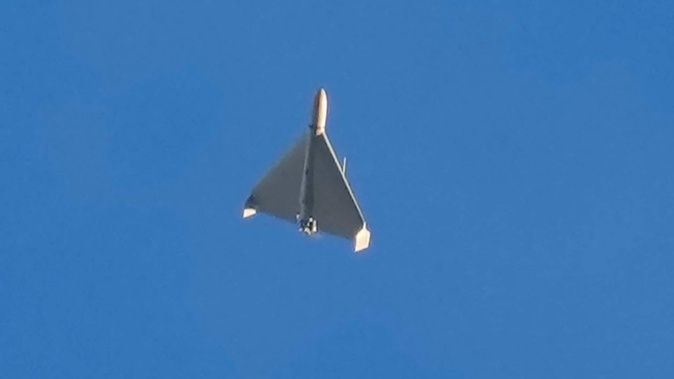
They are precise, small in size, able to effectively penetrate air defences when fired in groups and, above all, they’re cheap.
In Russia’s invasion of Ukraine, killer drones have cemented their reputation as a potent, cost-effective weapon that can seek out and destroy targets while simultaneously spreading the kind of terror that can fray the resolve of soldiers and civilians alike.
They’re also quickly surpassing missiles as the remote weapon of choice. Known as “the poor man’s cruise missile,” the flying death machines can flood any combat theatre much more cheaply.
Russia’s unleashing of successive waves of the Iranian-made Shahed drones over Ukraine has multiple goals — taking out power plants and other key infrastructure, crushing morale, and ultimately draining the enemy’s war chest and weapons as they try to take them out.
How do wartime drones work?
Drones, remote-controlled or preprogrammed, have been used extensively in battle to gather intelligence, direct artillery strikes and, to a lesser extent, drop explosives. There are many types. Sophisticated unmanned combat aerial vehicles that can launch missiles, such as the US-made Predator, are better known.
The Shahed drones that Russia has rebranded as Geran-2 are far cruder: Packed with explosives, they can be preprogrammed with a target’s GPS coordinates. They are known as suicide drones because they nosedive into targets and explode on impact like a missile.
That’s reminiscent of Japan’s World War II-era kamikaze pilots who would fly their explosives-laden aircraft into US warships and aircraft carriers.
Drones like the Shaheds are called loitering munitions by the military because when used at short range, they can hover over an area and then hit a target on an operator’s command.
According to the Ukrainian online publication Defence Express, which cites Iranian data, the delta-wing Shahed is 3.5m long, 2.5m wide and weighs about 200kg. It’s powered by a 50-horsepower engine with a top speed of 185km/h.
- Missiles and exploding drones again hit Ukraine’s power and water supplies
- Russian attack in Ukraine leaves significant damage to the region
The drone has previously been used in Yemen and in a deadly oil tanker attack last year, said Behnam Ben Taleblu, senior fellow at the Washington-based think tank Foundation for Defense of Democracies.
And while its range is about 1000km, drone expert Samuel Bendett with the CNA think tank, said the Shahed is being used in Ukraine at much shorter ranges. That’s because its GPS guidance system — which is vulnerable to jamming — isn’t very robust.
This undated photograph released by the Ukrainian military's Strategic Communications Directorate shows the wreckage of what Kyiv has described as an Iranian Shahed drone downed near Kupiansk, Ukraine. Photo / AP
Shaheds are known to have been controlled via radio under the Iranians. Whether Russia is capable of the same in Ukraine is unclear, though Ukrainians have reported seeing the drones change direction, suggesting at least some remote control.
Because they are cheap and plentiful, Russia has increasingly used Shaheds in Ukraine. Ukrainian President Volodymyr Zelenskyy said last week that Russia had ordered 2400 from Iran. Their use lets Russia avoid putting sophisticated aircraft and pilots at risk and save its limited stock of expensive long-range precision missiles.
In this week’s attack on the Ukrainian capital of Kyiv, the city’s mayor, Vitali Klitschko, said 28 drones made up waves of successive attacks. Fired from a truck launcher in rapid succession, the drones can fly low and slow, better able to avoid radar detection.
They don’t technically swarm, Bendett noted. That kind of sophisticated drone technology exists — when multiple uncrewed aerial vehicles communicate with one another. Instead, the Shahed is simply launched in bunches in order to overwhelm defences, particularly in civilian areas. “They know that most will not make it through,” he said.
Their power to terrorise exceeds their explosive might, however.
According to Mykola Bielieskov, a research fellow at Ukraine’s National Institute for Strategic Studies, the Shahed only carries a 40kg explosive charge, which pales in comparison to the explosive force that a conventional missile’s 480kg warhead can deliver at a much longer range.
“It is difficult to hit serious targets with such drones,” Bielieskov said.
But it’s also extremely difficult to shoot them down.
Small punch but low cost
At a mere US$20,000 (NZ$35,000) apiece, the Shahed is only a tiny fraction of the cost of a full-size missile. For example, Russia’s Kalibr cruise missiles, which have seen widespread use in eight months of war, cost the Russian military about $1 million (NZ$1.76m) each.
At such a low cost, the Shahed has been used effectively to saturate targets, whether a fuel depot or infrastructure and utilities like power or water stations. Russia has used them with precision in combination with intelligence drones to attack Ukrainian artillery, said Bendett.
Firefighters carry the body of a person killed after a drone fired on buildings in Kyiv, Ukraine on Monday. Waves of explosive-laden suicide drones struck Ukraine's capital as families were preparing to start their week early on Monday, the blasts echoing across Kyiv, setting buildings ablaze and sending people scurrying to shelters. Photo / AP
Despite its small size, the Shahed’s explosive charge appears powerful enough to do damage. In this week’s attacks, one drone struck an operations centre while another slammed into a residential building, ripping a large hole in it and collapsing at least three apartments, killing four people.
Bielieskov, from Ukraine’s National Institute for Strategic Studies, said Russia is now directing Shaheds at civilian rather than battlefield targets because Ukrainian forces have “learned how to fight them effectively,” intercepting a little more than half of them.
With no immediate end in sight, the conflict’s financial burden will weigh heavier on Moscow, which isn’t receiving billions in weapons transfers from Western nations like Ukraine is. As the conflict essentially becomes one of attrition — who can withstand that human, material and financial burden the longest — finding cheaper but still potent weapons will be key.
“Shahed-136 is a cheap version of a cruise missile, which Russia can’t produce fast,” said Bielieskov.
Taleblu said Russia will likely continue to boost its long-range strike capabilities with Iranian drones.
“This should raise alarm bells for Europe and the world,” he said.
Russian officials haven’t issued any data about the number of missiles fired during the conflict, but Ukraine’s defence minister recently alleged that Russia has used most of its high-precision missile arsenal.
A war of nerves
The incessant buzzing of the propeller-driven Shahed drones — dubbed “mopeds” and “lawnmowers” by combatants — can induce terror for anyone under its flight path because no one on the ground knows exactly when or where the weapon will strike.
Zelenskyy seized on the drones’ terror element, posting on social media: “The whole night, and the whole morning, the enemy terrorises the civilian population.”
Bielieskov conceded that Shahed drone strikes stir fears that Ukraine’s air defences are inadequate. But he said their use — even in large numbers — can’t reverse Ukraine’s battlefield gains. - AP
Take your Radio, Podcasts and Music with you

/cloudfront-ap-southeast-2.images.arcpublishing.com/nzme/CUWXU2OVDFAMLBM2ZRWCGBKLI4.JPG)
/cloudfront-ap-southeast-2.images.arcpublishing.com/nzme/WMK2AVZPTBBSJJV3QV5WQVQ34Q.JPG)








